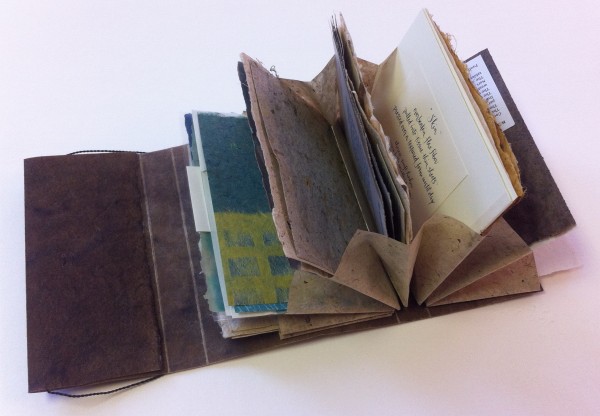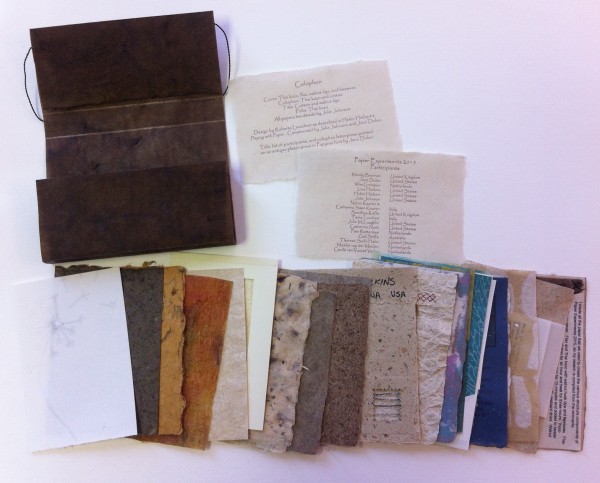Handmade Paper Exchange
I recently participated in a paper exchange called Paper Experiments, and look what I received in exchange for sending in a set of paper swatches! This swap has taken place before (at least once) and the participants vary from year to year. This year 16 papermakers from six countries performed their magic. Julie Johnson and Jane Dolan from Portland, OR created everything that tied this collaboration together: the title page and colophon, which they letterpress printed, and the paper cover/wrapper. I was delighted that they used the wrapper design by Roberta Lavadour from my book Playing With Paper (the expanding file folder book).

When I opened the package, I was struck by the paper that was created for the wrapper. Upon reading the description (thai kozo, flax, walnut dye, and beeswax) I was reminded of the diversity of handmade paper. If you and I took these same ingredients and made paper, its likely that they would look quite different. Adding beeswax to the cover (I assume that it was melted, brushed onto the paper and then heated so that the paper absorbed the wax) gives it a nice durable finish as well as a subtle translucency (which I love). This picture doesn’t do it justice.

And then opened the wrapper and had such fun looking at the paper samples. Wow!

Now, you needn’t follow along, but I’ve listed the types of paper from left to right as seen along the bottom row above (just to give you a sense of the variety and diversity): a watermarked cotton paper, paper made with chestnut skins, a pigmented hosta stem/kozo/ginkgo paper, kozo paper with procion dye and joomchi techniques, hemp parchment, flax fiber skin, kozo with elm seeds, kozo/tulip stem/cat tail seeds, ginger leaf/flax, hops/hemp, agave paper, 80 year old hemp yarn, pulp marbled cotton, pigmented gampi/abaca, pulp printing, copper patina on abaca/cotton, hanji/cotton/recycled, stcncil print on cotton/kraft, wet woven kozo,
I’m curious, for those of you who make paper (or collect it), do you keep samples? What is your system? And if you make paper, do you keep records/recipes of how you made them?

8 Comments
helen, it’s great to see this come to fruition. julie had told me about it–
What an impressive array of handmade paper!
I keep a binder full of samples of paper that I make directly from plants (ie. when I don’t use half-stuff). Jim Croft called in a “fibrary,” and I have used that portmanteau ever since.
I love that term too, Michelle! Clever Jim. So, samples but no recipes?
Love the term “fibrary”! I keep a binder of sample sheets for my handmade papers, though I admit that it occasionally gets raided for projects.
Do you keep any records with the samples Cathryn? How big is your fibrary?
I have one large (3 inch spine) binder. The samples are kept in archival plastic sleeves (the ones used for 8.5 x 11 inch photos) and are labelled on the front with a sticker listing contents. Not a very elegant storage system but it works. I keep meaning to make a nice cover for the binder but the job never gets far from the bottom of my to-do list! ; ]
I love this idea and would like to participate in such a book myself. How can I?